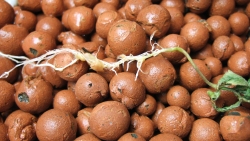This post may contain affiliate links. That means if you click and buy, I may receive a small commission. Please read my full disclosure policy for details.
The Urban Farmer, Issue #055 * Mother Earth News Hydroponics Primer * Kid’s Experiment * Hydro Tip

“When one of my plants dies, I die a little inside, too.” ~Linda Solegato
***
From Mother Earth News:
A HYDROPONIC GARDENING PRIMER
What exactly is hydroponic gardening? Though it may sound complicated, it’s really not. The word “hydroponic” comes from the Greek “hydro,” meaning water, and “ponic,” meaning work. The basic concept is this: growing plants in a nutrient-rich water solution rather than in soil. So, if you don’t use soil, what do you put the plant in? Instead of soil, hydroponic growing utilizes an inert growing media.
Some examples are coconut fiber, rockwool, and different types of “grow rocks.”Coconut fiber is also called “coir” and is similar to peat moss but is a renewable resource. It’s the fibrous husks of coconuts ground into a peat moss-like consistency. Rockwool is a moisture-retaining media made from basalt rock.
It is super-heated and melted down before being spun out like cotton candy. It’s then shaped into cubes, blocks, or slabs. Sunleaves Rocks are irregular-shaped, porous stones made of shale rock. They’re a byproduct of brick-making.
Hydrocorn is an expanded clay medium. It is puffed lava rock with a clay coating.
Growstones are very light pumice-like stones that are made out of recycled glass dug out of landfills.
All these inert medias are just used to give the roots something to anchor onto in order to support the plant. All the nutrients required by the plant to produce chlorophyll, which they use for food, must be provided by you. That is why it is very important to use a fertilizer that is specifically designed for hydroponics. Many soil fertilizers might not contain all the necessary elements the plant needs for healthy, vigorous growth.
You may think that hydroponics is a relatively new concept in gardening, but this assessment couldn’t be farther from the truth. The ancient Aztecs grew food crops on rafts in nutrient-rich lakes and streams, and it is also believed that the Hanging Gardens of Babylon may have been one of the first ventures into the wonder of hydroponics.
There are different types of hydroponic systems, most of which recirculate the nutrient solution, conserving water in the process. The simplest type of system is a deep water culture or DWC. All you need to make a DWC system is a reservoir (or bucket), a net basket, grow media, an air pump, and stone. You simply place the plant in the net basket with the grow stones (the rock-type media works best for this type), fill the bucket with water, and add hydroponic fertilizer. Oxygenate the water with the air stone and submerge the net basket with the plant in the solution. Voila!
There are, of course, other types of systems that have more components. Ebb-and-flow (also called fill-and-drain) systems employ the use of a grow tray and a reservoir. The grow tray sits on top of the reservoir and the nutrient water is pumped up from the bottom reservoir to the grow tray to feed the plants. It’s usually set on a timer, so when the flood cycle stops, the water drains back down into the reservoir. Many drip systems work this way also. The timer kicks on the drip cycle and the excess water drains back down.
With all types of hydro systems, there are a few general rules:
- Always maintain your pH (acidity or alkalinity) between 5.5 and 6.5
- Change out your reservoir with fresh water and nutrients every two weeks
- Always use hydroponic fertilizer
- Have fun growingI’m attaching a simple hydroponic experiment that is fun for children and adults to this blog to get you started down the hydro path. If you have any questions about hydroponic gardening feel free to contact me at the Worm’s Way Facebook page or website. Happy hydro!
HYDROPONICS EXPERIMENT FOR THE KIDS:

Hydro Tip of the Month
Know what you’re getting into
Ready to start a garden? You need to know what you would be getting into
before you commit to it. And especially before you spend any money on it.
First tour all the advantages of hydroponics. Then come back and explore the disadvantages.
We hope you have enjoyed this issue of The Urban Farmer Ezine. Each month, we will bring you another inspiring photo, gardening quote, or idea, plus fresh new hydroponics news, techniques & products.
Insiders tips to get you growing…

~Stella and Simon from Hydroponics-Simplified.

Reply